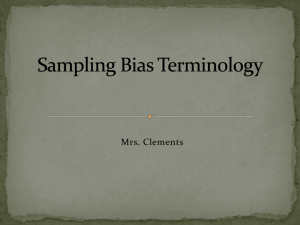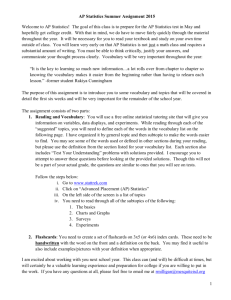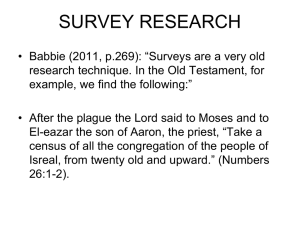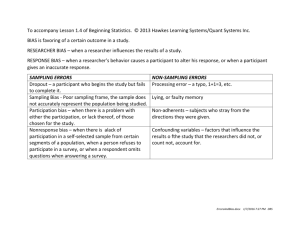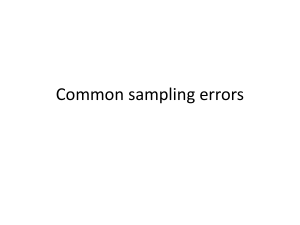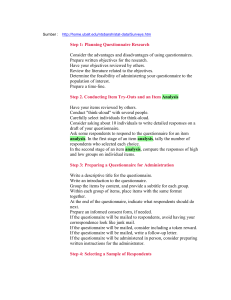EPE 773: Survey Research
advertisement
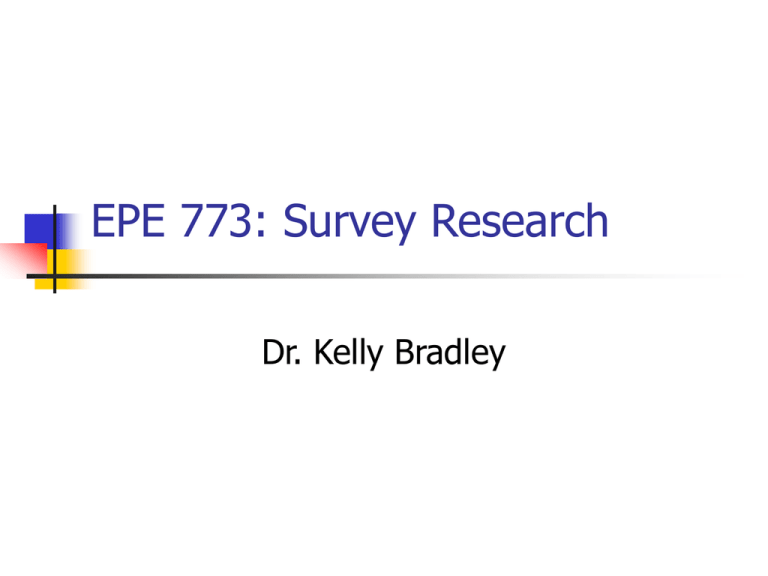
EPE 773: Survey Research Dr. Kelly Bradley Introductions Name Major and Advisor Why are you here? Fun fact Introduction to Survey Research Survey research is the most popular and common research method used in social sciences as well as in our society is one of the most important areas of measurement in applied social research. The broad area of survey research encompasses any measurement procedures that involve asking questions of respondents. What is a survey? A "survey" can be anything from a short paper-and-pencil feedback form to an intensive one-on-one indepth interview. Why conduct survey research? Gather information not available from other sources Unbiased representation of population interest (depending on sampling) Consistency of measurement Purpose The aim of survey research is to measure certain attitudes and/or behaviors of a population or a sample. The purpose of survey is to collect information from many individuals, hoping to understand them as a whole. Focus Survey research focuses on naturally occurring phenomena. Rather than manipulating phenomena, survey research attempts to influence the attitudes and behaviors it measures as little as possible. Most often, respondents are asked for information. Types of Data Survey research is primarily quantitative, but qualitative methods can be used too. Sampling A researcher may be able to gather data from all members of a population. Most of the time, the population is so large that researchers must sample only a part of the population and make conclusions about the population based on the sample. Because of this, gaining a representative sample is crucial in survey research. Possible sources of bias Demand characteristics Reactivity Response Bias Survey The survey is a non-experimental, descriptive research method. Surveys can be useful when a researcher wants to collect data on phenomena that cannot be directly observed. The major issues related to survey research are sampling issues and questionnaire design. These affect the accuracy, reliability, and representativeness of the research findings. Survey Research Classifications Classified according to PURPOSES Exploratory survey: to form general ideas about the research questions Descriptive survey: to collect more specific descriptions of the variables of interest Explanatory survey: to develop understanding of relationships among variables of interest Classification Classified according to TIME Cross-sectional survey: Data are collected at one point in time from a sample selected to represent a larger population. Longitudinal surveys: to collect data over time. Trend Studies: Surveys of sample population at different points in time Cohort Studies: Study of same population each time data are collected, although samples studied may be different Panel Studies: Collection of data at various time points with the same sample of respondents. Classification Classified according to DATA COLLECTION APPROACHES Face-to-Face Survey Mail Survey Telephone Survey Web Survey Survey Research Process Survey research (like all research) begins with identifying a problem and posing it as a research question. In higher education, Problem: "Freshman enrollments are down." Question: "What do college-bound high school students think of us?" Survey Research Process The survey research process includes the design of a survey, the acquisition of a sample, the fielding of the survey, and analysis and presentation of results. Conducting a Survey The steps and tasks in conducting survey planning sampling construction of questionnaire data collection translation of data analysis conclusions reporting Issues to consider in survey research What is your RESEARCH QUESTION? Population: accessibility, literacy, and language issues? Sampling: available data and participation of respondents? Questions: type, existing questionnaire? length, and Content: knowledge of? Bias: honest responses and social desirability? Administrative: cost, time, and equipment? complexity? Some ‘sites’ to explore Internet Sites Related to Survey Research http://www.srl.uic.edu/srllink/srllink.htm American Statistical Association; Survey Research Methods Section Information. http://www.stat.ncsu.edu/info/srms/srms.html
